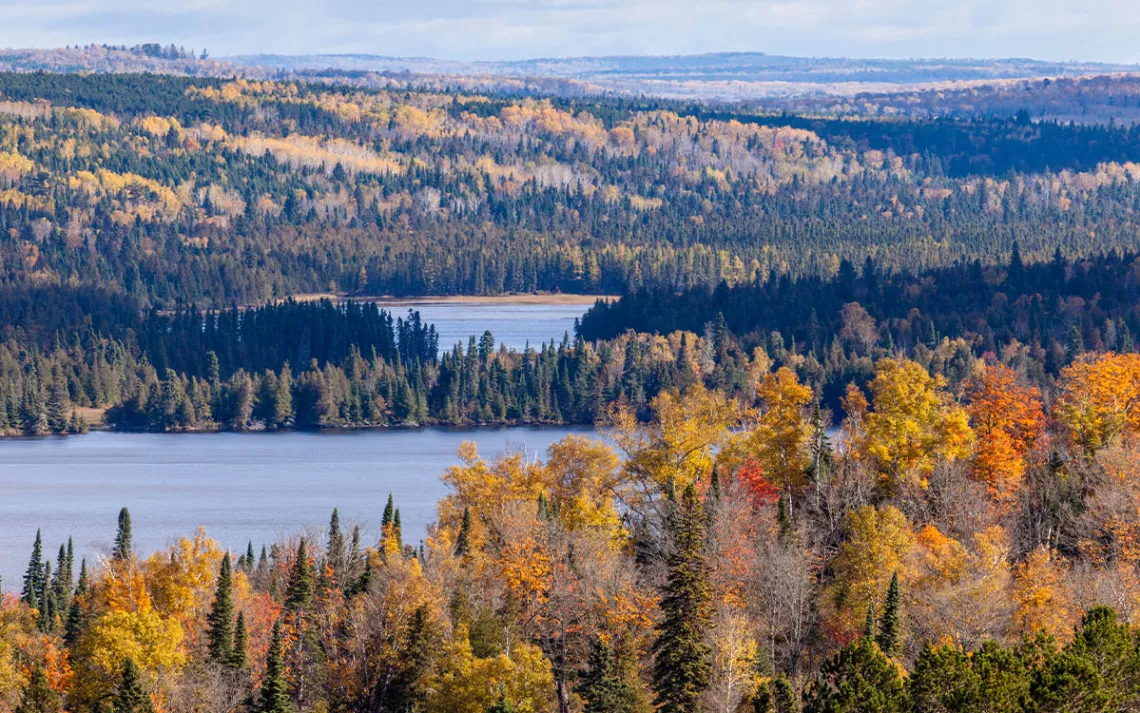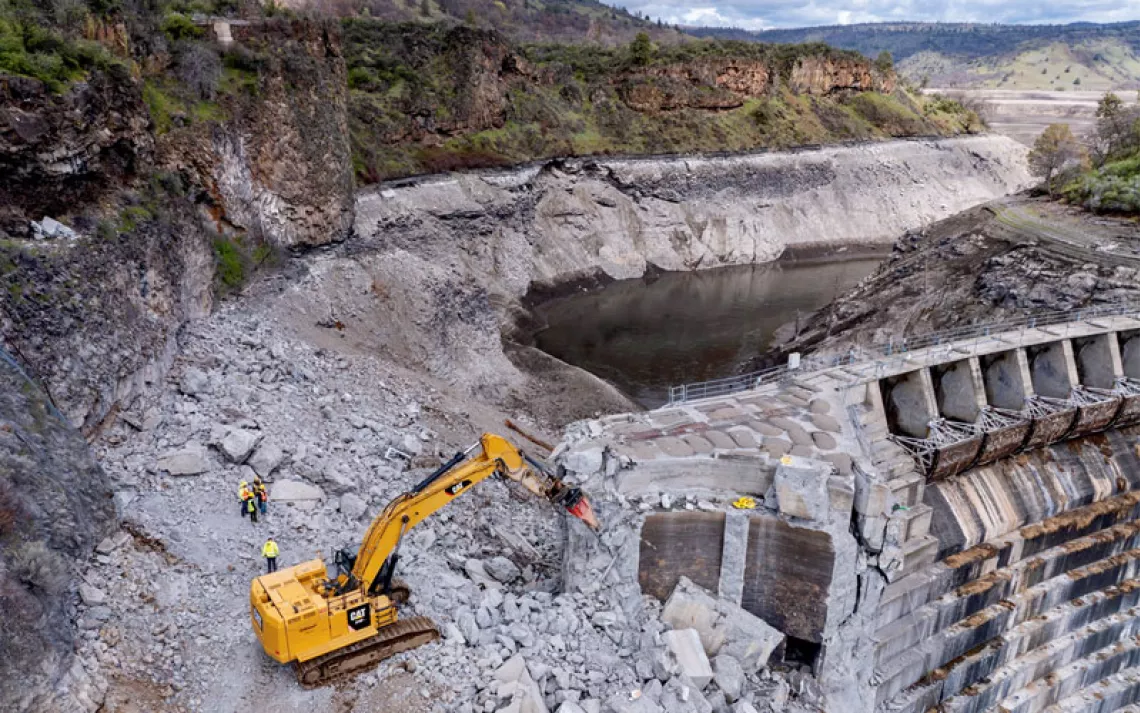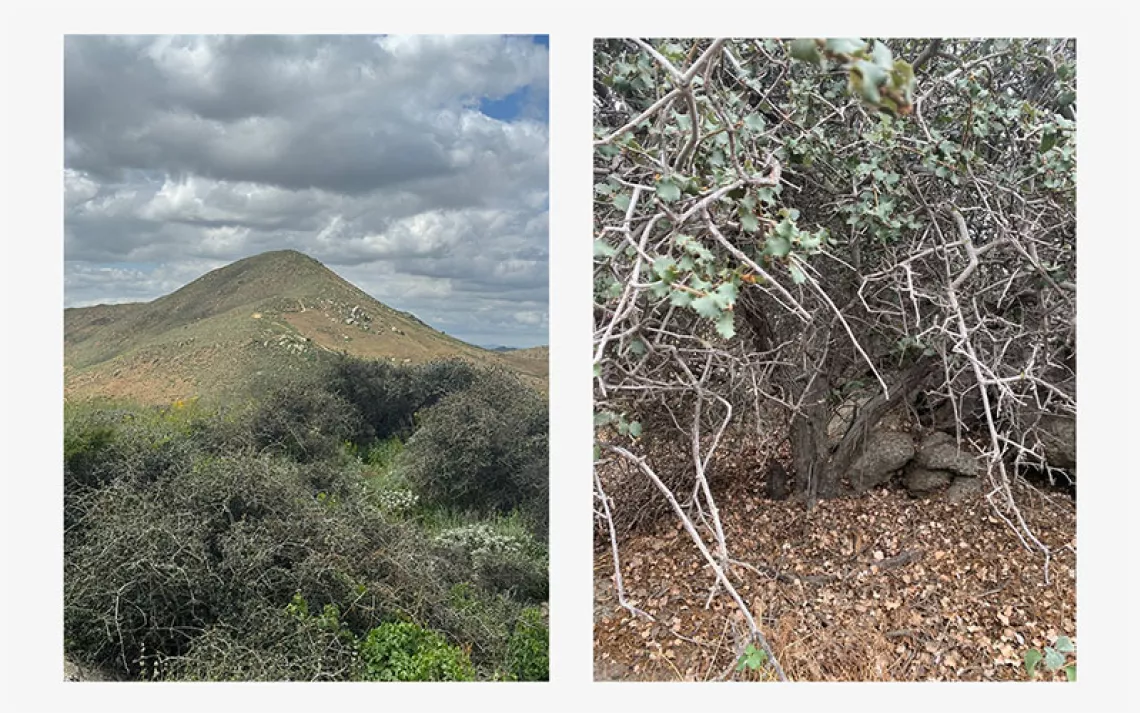Who Owns the Mountains in Lutsen?
Tribal rights and outdoor recreation collide in this pristine part of the Superior National Forest

A foliage vista of Caribou Lake and Bigsby Lake in the Superior National Forest, near the North Shore of Lake Superior, Minnesota. | Photo by igorkov/iStock
There’s a lot going on in a 495-acre stretch of the Superior National Forest, where Minnesota’s Sawtooth Mountains rise above the North Shore of Lake Superior. This land is home to some of the last old-growth northern white cedar stands in the state. And culturally significant sugar maples flush the slopes red every fall. This unique ecosystem, where the boreal forests of Canada meet the deciduous forests of Minnesota, also supports a wealth of biodiversity, including many rare species of birds and wildlife, such as lynx and gray wolves. Sensitive water sources flow through the ground, and abundant plant life sprouts from every nook and crevice.
This patch of forest also happens to be in ceded territory of the Grand Portage Band of Lake Superior Chippewa, Fond du Lac Band of Lake Superior Chippewa, and Bois Forte Band of Chippewa. Here, tribes retain treaty rights that have been in place for over a century. But recently, the area’s vertical relief, some of the steepest in Minnesota, caught the eye of the biggest ski resort in the state, Lutsen Mountains. The company’s interest ignited a heated debate over whether this land should be developed for skiing or protected from recreational use that would threaten the environment and tribal rights.
It’s a debate that’s playing out in many regions around the country, where competing demands for public land raise questions about how to balance booming outdoor recreation, the environment, wildlife, and Indigenous communities. How these issues are addressed plays a critical role in determining the future of national forests. What transpired in Minnesota at the end of 2023 isn’t necessarily the typical outcome, but it offers an interesting look into what happens when certain voices are elevated in land management conversations.
“We as tribal leaders have a responsibility to make sure there are resources for our next seven generations,” Robert Deschampe, the Grand Portage Band chairman, said in August 2023 as federal officials announced a draft decision on the development plans.
Attempts to take over the area started in December 2017, when Lutsen Mountain Corporation applied for a special use permit from the Superior National Forest, looking to nearly double the skiable terrain with a $59 million expansion that would add several new lifts, lodges, and ski runs to its resort’s footprint. Resort officials cited a growing demand for alpine skiing and an economic opportunity for businesses in Cook County, Minnesota.
But it was up to the US Forest Service to decide whether to greenlight the resort’s permit application—or to turn it down because of the ways it would negatively affect public land. To inform its decision, the Forest Service conducted an environmental assessment, as mandated by the National Environmental Policy Act, which requires all projects with a federal nexus to go through a review process. The agency also engaged the public through an open comment period, which drew hundreds of responses.
In their analysis, agency staff prioritized tribal input, which is something that’s become official protocol for managing land and resources in the Superior National Forest, thanks to a memorandum of understanding (MOU) that federal agents signed with the Bois Forte, Fond du Lac, and Grand Portage Bands of Lake Superior Chippewa in May 2023. The MOU recognizes the tribes as original stewards of the land and forges an official agreement to co-steward the 3.3-million-acre Superior National Forest and to protect their treaty rights granted under the 1854 Treaty of La Pointe with the US government.
Superior National Forest supervisor Thomas Hall says, MOU or not, the Forest Service has an obligation to engage the federally recognized tribes on land management decisions. “The MOU reinforces the relationship and tribal trust that already exists,” he said. “We have a responsibility to ensure the voice of the bands are heard and that they have a prominent role in deciding how this area will be managed.”
That dynamic made a big difference in the outcome of the Lutsen decision. When officials engaged the tribes on the resort’s proposal, they heard resounding opposition to the expansion proposal because of the many ways it would threaten their treaty rights and sacred resources.
“Impacts from the special-use permit would have affected our inherent rights to hunt, fish and gather,” Chairman Deschampe said in a joint news release issued by the Chippewa bands. “The expansion would further harm maple sugar bush and old-growth white cedar forest, cultural sites, and fish habitat.”
The expansion would have caused devastating damage to the North Shore Highlands ecosystem—which is unique to the area, thanks to the topography and climate-moderating effect of Lake Superior—and to critical resources for the tribes. They were especially concerned about its toll on rare northern white cedar stands, which are slow-growing and difficult to regenerate and are harvested by the tribes for traditional and ceremonial use.
The environmental review added further evidence that the expansion would come at a high, and potentially irreversible cost, especially for these stands and vulnerable plant communities, like sugar maple and sugar bush. It also found that development would threaten the health of the watershed and degrade water quality. Hall says the ecological toll of the expansion wasn’t in alignment with the Forest Plan of the Superior National Forest, which is a guiding force in land management decisions.
“Concerns about the impacts of development compounded, and we knew we couldn’t mitigate those concerns,” Hall said. “The adverse impacts associated with expansion onto National Forest Service land outweighed the benefits.”
So in December 2023, Forest Service staff finalized their decision. They decided to reject the resort’s development permit. While Hall acknowledged the value of winter recreation and the economic opportunity for local businesses, he found that the impacts to the environment and tribes far outweighed the potential benefits of an expansion. Over the course of several years, agency officials considered extensive input and analysis from public feedback, conversations with stakeholders, and the National Environmental Policy Act process, but ultimately, they prioritized tribal consultation and the Forest Plan.
While it may seem as if the Superior National Forest decision was formulaic and would be easily replicated in similar situations, the decision-making framework for land management cases can leave a lot of leeway for how these decisions unfold and which voices are incorporated. And it’s usually up to the presiding branch of the state or federal agency to determine what that process will look like—and who will be invited to the table.
Lutsen is one of many ski resorts touting ridership numbers as justification to expand onto public land, regardless of the impact on natural resources and wildlife. Wyoming’s Grand Targhee Resort is currently trying to expand onto important winter range for bighorn sheep, moose, mule deer, and elk. And Colorado’s Purgatory Resort was recently approved to develop ski terrain that could affect water quality and impact the habitat of Colorado River cutthroat trout and Canada lynx. One study counted 24 cases in which ski resorts have expanded onto National Forest Service land.
“Oftentimes, the biggest and most divisive environmental issues are decided by too few voices and the public gets cut out,” said JT Haines, Northeastern Minnesota director at the Minnesota Center for Environmental Advocacy, a nonprofit environmental law firm that opposed the Lutsen expansion. Haines points out that it’s also hard to justify expanding ski terrain when climate change is expected to bring warmer winters, more rain, and less snow to Minnesota.
“There’s an important balance to reach between private interests and public interests,” Haines said. “And too often in these situations, it can feel like it’s going the wrong way. The Superior National Forest decision is a refreshing example of a situation where the long-term public interest was elevated over some fairly specific private interests.”
 The Magazine of The Sierra Club
The Magazine of The Sierra Club



